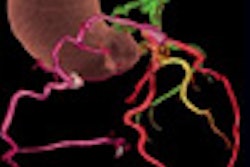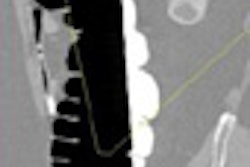Dual-source CT (DSCT) offers diagnostic accuracy comparable to that of invasive coronary angiography when it comes to identifying significant coronary artery stenoses, researchers report. Investigators presented the findings at the 2007 annual scientific sessions of the American Heart Association (AHA) in Orlando, FL.
"At heart rates greater than 60 bpm, motion artifacts can render a number of images from 64-slice CT unassessable," explained lead investigator Dr. Johannes Rixe, a cardiologist at Kerckhoff Heart Center in Bad Nauheim, Germany. "So we set out in this study to look at the feasibility of dual-source CT as a means of assessing coronary artery stenoses."
To test the hypothesis that DSCT could match angiography in accuracy, Rixe and his team examined 76 consecutive patients with a mean age of approximately 66 years (29 women and 47 men, ages 65.5 ± 10). All the study participants were suspected of having coronary artery disease.
Clinicians performed DSCT angiography on a Somatom Definition (Siemens Medical Solutions, Erlangen, Germany) scanner with a rotation speed of 330 msec, collimation of 64 x 0.6 mm, and temporal resolution of 83 msec. They made no attempt to normalize patient heart rates prior to examination.
Datasets were reconstructed at 5% intervals, with two expert observers evaluating the images. The protocol defined a stenosis of greater than 50% diameter reduction as significant. Coronary segments that could not be evaluated were labeled as false positives.
The investigators examined a total of 304 coronary arteries and 1,160 coronary segments, with all but two segments able to be visualized without artifacts. They were successful in detecting 58 coronary stenoses by DSCT angiography.
In all, 237 coronary arteries were determined to be true negative at DSCT, with only one lesion being missed by DSCT. Based on segmental analysis, investigators found a sensitivity of 98.3%, specificity of 96.7%, and an overall accuracy of 97%.
Moreover, the clinicians found that sensitivity increased to 100% on a per-patient basis; specificity was 83.3% and overall accuracy was 92.1% compared to invasive angiography.
Rixe also noted that positive and negative predictive values were 99.9% and 86.6%, respectively, in the segment-based analysis; 100% and 86.9%, respectively, in the patient-based analysis.
While Rixe highlighted the preliminary nature of these findings, he suggested that "we may see more use of dual-source in clinical settings in the future, but we may need to wait and see what happens with 256-slice CT."
By Jerry Ingram
AuntMinnie.com contributing writer
December 4, 2007
Related Reading
Low-dose coronary CTA diagnoses most patients, November 28, 2007
Michigan heart center aims DSCT guns at image quality, October 8, 2007
Dual-source coronary CTA images the calcium-burdened, April 13, 2007
Dual-source imaging promises better CT scanning, June 15, 2007
Siemens launches new dual-source CT technology, November 17, 2005
Copyright © 2007 AuntMinnie.com




















